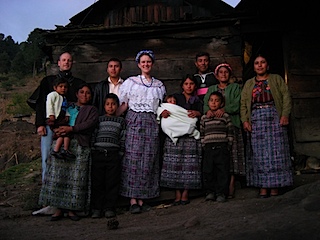Getting to Know the Q’anjob’al People
by Emily Richardson Fanjoy
Guest Columnist
In signing up to be a Peace Corps volunteer, you’re really signing up for twenty-seven months of adventure. It’s an adventure in the sense that you don’t know much of what’s going to happen: you don’t know where you’ll be living, who you’ll be working with, or in some cases what you’ll really be doing… until you’re there. Almost a year ago, in the first week of July, we had a general meeting for all of the new health volunteers to meet our future supervisors. Our assignment was a tiny village, remote and 100% indigenous. We’d never heard of it.
“Some indigenous communities are very closed to outsiders,” our new supervisor said. “They don’t want foreigners near them and they won’t listen to anything you have to say.”
We’d worked in such communities during training, and I thought, “Wonderful…”
He continued, “I just want you to know that our community, the Q’anjob’al Maya, aren’t like that. They’re more open and friendly.”
During our initial visit to the community, we were welcomed with firecrackers and flowers and a community-wide gathering. They all came together to see us, hear who we are and what we proposed to do, and to cast a community-wide vote on whether or not we could stay. We had no idea any of this was going to happen. We sat through a two hour meeting in a language we didn’t understand, listening to the nurse translate as elders spoke in our favor, hoping they wanted us and not knowing what we’d do if they didn’t. Thankfully, the vote fell in our favor, and nearly 200 Q’anjob’alese lined up to sign an act promising to personally safeguard our security. Most of them, being illiterate, signed with a thumbprint.
After they had voted us in, because as one man said, “If we don’t vote for them to stay we’ll never know who they are or what they would’ve done here,” we were invited to a dinner of chicken soup and tortillas. Guatemalans, especially in rural areas, use food to demonstrate their hospitality. We ate as much as we could stomach in order to please them; they really like good eaters. Thus began our relationship with our village.
We live in northern Huehuetenango, just south of Mexico, in a house on stilts that stands in the middle of a corn plot on the side of a steep mountain. This is not tropical Guatemala. Nine months of the year it rains almost every day for most of the day and almost not at all during the other three months. It’s often cold enough to see your breath; sometimes we even get ice. Our neighbors are subsistence farmers, growing wheat, corn, and potatoes; they supplement their income when they can with menial jobs and remissions money their relatives send back from the United States. Nearly everyone raises animals, so living here is a lot like living on a farm. We fall asleep to donkeys braying and wake up to roosters crowing. Within 200 feet of our house you can find chickens, turkeys, ducks, sheep, pigs, cows, donkeys, dogs, cats, and a horse or two.
Before mass migration to the U.S., everyone lived in homes made of adobe, with wooden shingles and a dirt floor. Families earned extra money by migrating during harvest season, November through January, picking cotton, coffee, and fruit on massive plantations on the coast. Nowadays, many families have been able to use remissions money to build concrete block homes, sometimes multi-level, with proper floors.
The women of our village still wear their traditional dress, but the men have now switched from their leather sandals, white pants, and wool tunic to cowboy boots, khakis, and button-up shirts. Slowly but surely, their traditional dress is being replaced by used American clothes, exported and resold cheap in the local market. Only a few elders (and sometimes my husband) still wear the capishay, their traditional poncho.
In the year we’ve been here, we’ve worked slowly and steadily to gain people’s trust. Children no longer scream in terror and hide when they see us. Villagers invite us into their homes, and we eat whatever they offer: boiled cowbelly soup, roasted dragonflies with lime and salt, and always pile upon pile of corn tortillas. We study the local language, with its gurgling sounds and tongue clicks. And every time we say anything, we are greeted with shock, surprise, and hysterical laughter. Two giant gringos trying to speak a Mayan language! The hilarity is too much for them. Now, after almost a year, they tell us with broad smiles, “You’re almost there! You can almost speak our language!” We’ve learned how to kill pigs, sheep, and chickens for eating. I’ve been shown how to properly tie a corte, their traditional skirt of yards upon yards of wrapped fabric. And we both know how to dance the marimba, the music of Guatemala.
They’ve opened up to us, telling us their stories and asking us about ours. We expose them to
new ideas, and they share their age old customs and culture with us. In working here, what I find most interesting is not all the ways we are different, but rather all the ways we are so similar. I’m very privileged to have this opportunity to live and learn with the Q’anjob’al people, people that, just a year ago, I didn’t know existed; and now you know about them, too.